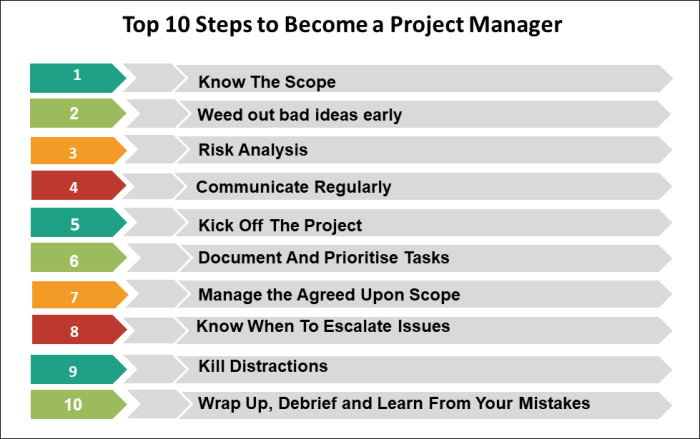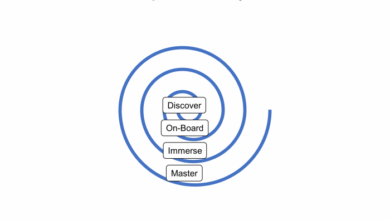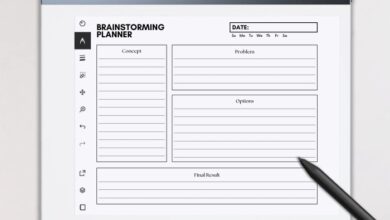
How to become a project manager? This guide dives deep into the world of project management, equipping you with the knowledge and skills to excel in this dynamic field. From understanding the fundamentals to mastering crucial methodologies and tools, we’ll explore everything you need to know to successfully navigate the complexities of project execution.
We’ll cover essential skills like communication, leadership, and problem-solving, plus the various project management methodologies such as Agile and Waterfall. We’ll also discuss crucial aspects of project planning, execution, tools, and closure, providing practical insights and real-world examples to illustrate key concepts. The journey to becoming a project manager starts now!
Introduction to Project Management
Project management is the application of knowledge, skills, tools, and techniques to project activities to meet project requirements. It encompasses the entire project lifecycle, from initiation to closure, ensuring that projects are completed on time, within budget, and to the required quality standards. Effective project management is crucial for achieving organizational goals and delivering value to stakeholders.Project management is not just about planning and executing tasks; it’s a holistic approach to managing resources, risks, and stakeholders to achieve desired outcomes.
It’s a dynamic process that adapts to changing circumstances and leverages best practices to enhance efficiency and effectiveness.
Key Characteristics of a Successful Project Manager
Successful project managers possess a unique blend of technical skills, interpersonal abilities, and leadership qualities. They are adept at planning, organizing, and controlling project activities while effectively communicating with team members, stakeholders, and clients. Crucially, they must possess strong problem-solving skills to navigate challenges and adapt to unexpected situations.
Importance of Project Management Across Industries
Project management is critical across a broad spectrum of industries. From software development to construction, healthcare to marketing, project management principles provide a structured framework for achieving goals and managing resources effectively. By standardizing processes and improving communication, project management helps organizations streamline operations, increase productivity, and ultimately enhance profitability.
Project Management Methodologies
Different project management methodologies offer unique approaches to managing projects. These approaches vary in their emphasis on structure, flexibility, and stakeholder involvement. Understanding the strengths and weaknesses of each methodology allows organizations to select the best fit for their specific project needs.
| Methodology | Description | Strengths | Weaknesses |
|---|---|---|---|
| Agile | An iterative and incremental approach emphasizing flexibility and adaptability. Focuses on delivering working software in short cycles (sprints). | High responsiveness to change, improved customer satisfaction, increased transparency, faster time to market. | Requires highly skilled and self-organized teams, potentially less suitable for projects with rigid requirements, can be challenging to estimate time and resources accurately. |
| Waterfall | A linear, sequential approach where each phase must be completed before the next begins. Clearly defined stages and deliverables. | Well-defined scope and deliverables, easier to estimate time and resources, suitable for projects with stable requirements. | Less adaptable to change, slower time to market, potential for delays in later phases due to issues in earlier stages, limited customer involvement during the development process. |
Essential Skills for Project Managers

Becoming a successful project manager requires a unique blend of technical skills, interpersonal abilities, and leadership qualities. Effective project management hinges on the ability to navigate complexities, motivate teams, and deliver projects on time and within budget. This requires a deep understanding of the project lifecycle, from initiation to closure, and the proficiency to adapt to changing circumstances.
Strong communication, problem-solving, and decision-making skills are crucial for success in this dynamic field.
Technical Skills
Project managers need a strong foundation in technical skills to effectively manage projects. These skills are essential for understanding project requirements, planning, and execution. Top 5 crucial technical skills include:
- Project Planning and Scheduling: Proficiency in tools like Gantt charts, critical path methods, and project management software is vital for visualizing tasks, dependencies, and timelines. This ensures that projects stay on track and resources are allocated effectively. For instance, a skilled project manager using a Gantt chart can anticipate potential delays and adjust the schedule proactively.
- Budgeting and Cost Control: Understanding financial aspects of projects is paramount. Project managers must develop budgets, track expenditures, and manage costs effectively to stay within the allocated budget. This often involves negotiating contracts, obtaining approvals, and analyzing variances.
- Risk Management: Identifying, assessing, and mitigating potential risks is a critical skill. This involves proactive risk analysis, developing contingency plans, and monitoring risks throughout the project lifecycle. For example, a project manager might identify the risk of material shortages and develop a plan to secure alternative suppliers.
- Resource Management: Effectively allocating resources, including personnel, equipment, and materials, is essential for timely project completion. Project managers must understand the availability of resources, their limitations, and their impact on project timelines. This often involves coordinating with different teams and departments.
- Quality Management: Ensuring that project deliverables meet the required quality standards is crucial. This includes implementing quality control measures, conducting quality audits, and resolving any quality issues promptly. This is exemplified by a project manager who uses quality control checklists to ensure consistent standards across different phases.
Communication and Interpersonal Skills
Strong communication and interpersonal skills are fundamental for project managers. They facilitate collaboration, conflict resolution, and effective stakeholder management. These skills are crucial for conveying information clearly and concisely to all stakeholders. Building strong relationships and fostering a positive team environment is vital for success.
Problem-Solving and Decision-Making Abilities
Project managers frequently encounter unforeseen challenges and obstacles. Effective problem-solving and decision-making skills are essential for navigating these complexities and making sound judgments under pressure. This includes analyzing situations, evaluating options, and selecting the best course of action. Examples of such abilities include using data analysis to understand project issues and identifying root causes.
Leadership Styles
Different leadership styles can be effective in project management contexts. There is no one-size-fits-all approach. The most effective style depends on the specific project and team dynamics. Consider transformational leadership, which inspires and motivates team members, and servant leadership, which focuses on supporting team members’ needs.
Conflict Management
Conflict is inevitable in any project. Effective conflict management strategies are essential for maintaining a positive and productive work environment. Strategies include active listening, understanding different perspectives, and finding mutually agreeable solutions. Examples of successful conflict resolution include facilitating constructive dialogue and employing mediation techniques.
Team Building and Maintenance
Building and maintaining strong project teams is crucial for success. This involves fostering a collaborative environment, promoting open communication, and recognizing and rewarding team members’ contributions. Strategies include team-building activities, regular team meetings, and open communication channels.
Stakeholder Management
Project stakeholders have varying needs and expectations. Understanding these differences is crucial for successful project management. A comprehensive approach involves identifying key stakeholders, analyzing their needs, and tailoring communication to address those needs.
| Stakeholder Type | Needs |
|---|---|
| Clients | Deliverables that meet their expectations and specifications |
| Project Team | Clear communication, support, and opportunities for growth |
| Sponsors | Regular updates, progress reports, and successful project completion |
| Suppliers | Clear contract terms, timely payments, and smooth project coordination |
| Management | Project compliance, budget adherence, and timely completion |
Project Management Methodologies
Choosing the right project management methodology is crucial for success. It dictates the structure, processes, and communication strategies employed throughout the project lifecycle. Understanding the various methodologies available empowers project managers to select the best approach for a specific project, maximizing efficiency and minimizing risks.Different project management methodologies offer unique approaches to organizing tasks, managing resources, and ensuring project completion within time and budget constraints.
Understanding their strengths and weaknesses is essential for making informed decisions.
Agile Methodology
Agile methodologies prioritize flexibility and adaptability. They emphasize iterative development, continuous feedback, and collaboration among team members. This approach is particularly effective for projects with evolving requirements or those needing rapid responses to changing market conditions.
- Agile emphasizes iterative development cycles, allowing for adjustments based on feedback received at each stage.
- Collaboration and communication are paramount in Agile, with teams working closely together to ensure alignment and transparency.
- Customer involvement is key, with feedback loops incorporated throughout the development process to ensure the product meets the customer’s needs.
- Flexibility is central to Agile, enabling projects to adapt to changing requirements and unforeseen challenges.
Waterfall Methodology
The Waterfall methodology, a linear approach, defines a sequential flow of tasks, moving from one phase to the next in a structured manner. This approach is suitable for projects with well-defined requirements and limited scope changes.
- Waterfall’s sequential nature ensures that each phase is completed before the next begins, promoting a structured approach.
- This methodology works well for projects with stable requirements, minimizing scope creep.
- A detailed project plan is essential for Waterfall projects, outlining the tasks and timelines in each phase.
- However, the rigid nature of Waterfall can be a drawback, making it less adaptable to changing circumstances.
Scrum Framework, How to become a project manager
Scrum is an Agile framework that uses iterative sprints to deliver project increments. It emphasizes iterative development, continuous feedback, and cross-functional teams. Scrum is particularly effective for complex projects requiring close collaboration and adaptation to evolving needs.
- Scrum utilizes short sprints, typically 1-4 weeks long, to deliver functional increments of the project.
- Daily Scrum meetings facilitate communication and coordination among team members.
- Regular sprint reviews allow stakeholders to provide feedback and ensure the project aligns with their expectations.
- Product Backlog refinement ensures the project stays aligned with evolving needs.
Kanban Methodology
Kanban, another Agile approach, focuses on visualizing workflow, limiting work in progress, and continuously improving processes. It is well-suited for projects requiring continuous delivery and frequent updates.
- Kanban uses a visual representation of the workflow, providing transparency and clarity.
- Limiting work in progress (WIP) helps manage task dependencies and prevents bottlenecks.
- Continuous improvement is a core principle, allowing teams to identify and address inefficiencies.
- Kanban’s flexibility makes it suitable for projects with variable workloads and fluctuating demand.
Choosing the Right Methodology
Selecting the appropriate methodology depends on the project’s specific characteristics. Factors such as project complexity, team size, and required flexibility play a significant role in the decision-making process.
So, you’re aiming to become a project manager? It takes more than just good organization; you need efficient tools. One key element is leveraging productivity apps, and checking out 5 best chrome productivity apps can dramatically boost your workflow. These tools can help you manage tasks, track progress, and collaborate effectively, all crucial skills for project managers.
Ultimately, mastering these tools will give you a significant edge in your project management journey.
- Projects with stable requirements and a well-defined scope often benefit from the structured approach of Waterfall.
- Agile methodologies, like Scrum and Kanban, are ideal for projects with evolving needs, requiring frequent adaptation and customer collaboration.
- The chosen methodology should align with the project’s unique characteristics and the team’s capabilities.
Agile vs. Waterfall
| Feature | Agile | Waterfall |
|---|---|---|
| Requirements | Evolving | Fixed |
| Development | Iterative | Sequential |
| Feedback | Continuous | At the end of each phase |
| Flexibility | High | Low |
| Team Collaboration | High | Moderate |
Project Planning and Execution
Project planning and execution are the heart of any successful project. This crucial phase involves defining the project’s scope, setting realistic timelines, allocating resources, and meticulously managing risks. A well-defined plan, coupled with effective execution strategies, dramatically increases the likelihood of achieving project objectives on time and within budget. Thoroughness and proactive risk management are key elements in this stage.
Defining Project Scope and Objectives
Clearly defining the project scope and objectives is paramount to success. This involves outlining precisely what the project entails, what deliverables are expected, and who is responsible for achieving those deliverables. Unclear project boundaries often lead to scope creep, increasing costs and delaying completion. Well-defined objectives, on the other hand, serve as a guiding compass, ensuring all project activities align with the overall goals.
A comprehensive scope statement should include a detailed description of the project’s goals, deliverables, and boundaries.
Creating a Project Schedule and Budget
Creating a realistic project schedule and budget is crucial for effective project management. This requires careful estimation of task durations, resource allocation, and potential costs. A detailed schedule, often represented in a Gantt chart, visualizes task dependencies and timelines, allowing for efficient monitoring and proactive adjustments. The budget should be meticulously itemized, including all anticipated expenses, from materials to personnel costs.
Adequate contingency should be planned for unforeseen circumstances. Using a project management software or spreadsheet can assist in tracking progress and managing budgets.
Risk Assessment and Mitigation Strategies
Risk assessment and mitigation strategies are critical for proactive project management. Identifying potential risks and developing mitigation plans can significantly reduce the impact of unforeseen issues. A risk register, a crucial tool, should document identified risks, their potential impact, and the proposed mitigation strategies. These strategies should be prioritized based on their likelihood and potential impact. By anticipating and addressing potential problems early, projects can navigate challenges with greater resilience.
Quality Control in Project Management
Maintaining quality control throughout the project lifecycle is essential for delivering high-quality results. Establishing clear quality standards and procedures ensures consistency and adherence to project specifications. Regular quality checks, audits, and feedback loops contribute to the continuous improvement of the project’s output. This proactive approach helps prevent defects and ensures the final product meets the required standards.
Tracking Project Progress
Effectively tracking project progress is essential for maintaining control and identifying potential deviations from the plan. Regular progress reports, using metrics like milestones and task completion rates, provide valuable insights into the project’s status. Tools like project management software and dashboards can automate this process, allowing for real-time monitoring and reporting. By staying informed about project progress, managers can make necessary adjustments and prevent delays or cost overruns.
Project Documentation Tools and Templates
Utilizing appropriate project documentation tools and templates streamlines project management. These tools enhance communication, ensure consistency, and facilitate collaboration among project team members. Examples include project charters, scope statements, risk registers, and issue logs. Templates provide a standardized framework for documenting project information, promoting clarity and reducing ambiguity. Using a shared platform for project documentation can facilitate easier access and version control.
Project Lifecycle Phases
| Phase | Description |
|---|---|
| Initiation | Defining project goals, objectives, and scope. |
| Planning | Developing detailed plans, schedules, and budgets. |
| Execution | Carrying out project tasks and activities. |
| Monitoring and Controlling | Tracking progress, managing risks, and making necessary adjustments. |
| Closure | Finalizing project deliverables, documenting lessons learned, and formally closing the project. |
Project Management Tools and Software

Project management software has become indispensable for modern project managers. These tools streamline workflows, track progress, and facilitate communication, ultimately contributing to project success. Choosing the right software depends on the specific needs of the project and the team. This section will delve into popular tools, their features, and how to select the optimal solution for your project.
Popular Project Management Software Tools
A multitude of project management software tools are available, each with its unique strengths. Some of the most popular include Asana, Trello, Monday.com, Jira, and Microsoft Project. Each offers a range of features, and the best choice depends on the complexity of the project and the team’s preferences.
Comparison of Features and Functionalities
Different project management tools cater to various project types and team sizes. Asana, known for its simplicity, excels in task management and collaboration. Trello, with its visual Kanban boards, is well-suited for visualizing workflows and progress. Monday.com offers robust customization options, making it suitable for complex projects requiring specialized features. Jira, primarily used for Agile development, provides robust issue tracking and workflow management.
Microsoft Project, on the other hand, is powerful for large-scale projects and offers detailed scheduling capabilities.
So, you’re aiming to become a project manager? It takes more than just good organization skills. The future, as predicted by CES, is likely to bring a lot of changes in project management, particularly in areas like automation and AI. Understanding these trends from resources like the future according to CES will help you adapt and learn the new skills needed.
Ultimately, staying updated on these emerging trends will be key to becoming a successful project manager in the years to come.
Choosing the Right Tool for a Specific Project
Selecting the right project management tool is crucial for project success. Consider factors such as project complexity, team size, required features, and budget. A simple project with a small team might benefit from a straightforward tool like Asana or Trello. More complex projects with larger teams might necessitate a more robust platform like Monday.com or Jira. Microsoft Project is ideal for intricate projects involving extensive scheduling and resource allocation.
A thorough evaluation of these factors is critical to ensuring the chosen tool effectively supports the project’s needs.
Importance of Using Project Management Software
Project management software significantly enhances project efficiency and reduces errors. It centralizes information, automates tasks, and improves communication, leading to better project outcomes. Tools provide real-time updates, enabling teams to proactively address potential issues and adjust plans as needed. By fostering transparency and collaboration, project management software mitigates the risk of miscommunication and delays.
Using Project Management Software for Task Assignment and Tracking
Project management software facilitates seamless task assignment and tracking. Teams can assign tasks to specific individuals, set deadlines, and monitor progress. Features like task dependencies and notifications help ensure tasks are completed on time and in sequence. Real-time updates on task completion and progress keep stakeholders informed and provide a clear view of project status.
Comparison Table of Pricing and Features
| Software | Pricing | Key Features ||—|—|—|| Asana | Free plan available, paid plans start at $10.99/user/month | Task management, collaboration, project planning || Trello | Free plan available, paid plans start at $5/user/month | Kanban boards, visual workflows, collaboration || Monday.com | Free plan available, paid plans start at $12/user/month | Customization, automation, project management || Jira | Paid plans starting at $7.50/user/month | Agile development, issue tracking, workflow management || Microsoft Project | Paid plans starting at $8.99/user/month | Detailed scheduling, resource management, reporting |
Choosing the right software requires careful consideration of the project’s specific needs and the team’s preferences. A tool that’s too complex for a small project can be overwhelming, while a simple tool for a large project might not provide the necessary features.
Project Closure and Evaluation
Project closure isn’t just about formally ending a project; it’s a crucial phase for learning, improving, and ensuring future success. A well-managed closure process allows for a thorough review of the project’s performance, identifying both strengths and weaknesses. This knowledge is invaluable for future endeavors. Effective project closure also involves ensuring all deliverables are handed over to the appropriate parties, minimizing disruption and maximizing stakeholder satisfaction.Thorough project closure and evaluation processes are essential for continuous improvement.
By meticulously documenting lessons learned and implementing corrective actions, project managers can refine their methodologies and strategies. This cyclical process fosters a culture of learning and adaptability, leading to more successful projects in the future.
Project Closure and Handover
The project closure phase involves formally ending the project and transferring all deliverables and responsibilities to the client or stakeholders. This includes ensuring all documentation, training materials, and any associated assets are properly handed over. Clear communication and a well-defined handover plan are crucial to avoid confusion and ensure a smooth transition. Thorough documentation of the handover process helps track responsibilities and prevents future conflicts.
Post-Project Reviews and Evaluations
Post-project reviews and evaluations provide an opportunity to analyze the project’s performance against predefined objectives and benchmarks. They help identify successes, areas for improvement, and lessons learned. Review meetings should involve key stakeholders, including project sponsors, team members, and clients, to ensure diverse perspectives are considered.
Lessons Learned and Application to Future Projects
Identifying and documenting lessons learned is a critical aspect of project closure. This includes analyzing successes, failures, and unexpected events, and documenting the root causes. The insights gained from these analyses can be applied to future projects to prevent similar issues and enhance efficiency. This iterative process of identifying, documenting, and applying lessons learned is key to project management improvement.
“Lessons learned should be concise, actionable, and readily accessible for future reference.”
Effective Project Closure Reports
Effective project closure reports provide a comprehensive summary of the project’s lifecycle, including its objectives, progress, outcomes, and lessons learned. These reports are crucial for evaluating project performance and facilitating knowledge transfer. A well-structured report should include sections on project objectives, key deliverables, progress tracking, and budget and schedule adherence.
So, you’re aiming to become a project manager? It’s a rewarding path, but requires a blend of skills. Learning project management methodologies like Agile or Waterfall is crucial. Also, understanding the ever-evolving technological landscape is key, like how AMD is imagining a future steeped in computing here. This means keeping your skills sharp, and adapting to the constantly changing tech demands.
Ultimately, experience in various project roles is invaluable for this career path.
- Clearly state the project’s objectives and how they were met or not.
- Detail the project’s timeline, including key milestones and any deviations.
- Quantify the project’s success by highlighting key metrics and achievements.
- Summarize budget performance, including any variances and explanations.
- Document lessons learned and recommendations for future projects.
Ensuring Project Success and Stakeholder Satisfaction
Ensuring project success and stakeholder satisfaction requires proactive communication, clear expectations, and a focus on achieving the desired outcomes. Regular updates, clear documentation, and proactive issue resolution are essential components of maintaining stakeholder satisfaction throughout the project lifecycle. A commitment to transparency and open communication can mitigate potential issues and build trust with stakeholders.
Strategies for Project Success
- Clearly define project objectives and deliverables.
- Establish a robust communication plan.
- Develop a comprehensive risk management strategy.
- Maintain strong stakeholder relationships.
- Utilize appropriate project management tools and methodologies.
Key Steps in the Project Closure Process
A well-defined project closure process ensures a smooth transition and efficient knowledge transfer. This structured approach minimizes disruptions and maximizes the value derived from the project.
| Step | Description |
|---|---|
| 1. Project Completion | Verify all deliverables are complete and accepted. |
| 2. Final Documentation | Compile final reports, documentation, and handover materials. |
| 3. Stakeholder Communication | Communicate project closure details to all stakeholders. |
| 4. Project Closure Meeting | Formalize project closure with a meeting to discuss outcomes. |
| 5. Lessons Learned | Identify and document lessons learned for future projects. |
| 6. Final Review and Approval | Obtain final approvals from stakeholders and project sponsors. |
Resources for Project Managers: How To Become A Project Manager
Becoming a successful project manager requires continuous learning and development. Beyond the core knowledge of project management methodologies and tools, a robust support network and access to quality resources are crucial for navigating the complexities of projects. This section highlights essential resources to enhance your project management journey.
Reputable Online Resources for Project Management Education
Online platforms offer a wealth of project management resources, often accessible at a fraction of the cost of traditional classroom training. These platforms provide structured courses, interactive exercises, and opportunities to connect with other project managers. Sites like Project Management Institute (PMI) online courses, Udemy, Coursera, and edX provide comprehensive project management training programs, catering to various skill levels and project types.
These resources can help project managers stay updated with industry best practices and emerging trends.
Books and Articles on Project Management
Project management literature is vast and diverse, offering valuable insights into different methodologies and approaches. Reading books and articles from recognized authors and publications helps project managers gain a deeper understanding of project management principles and strategies. Books like “Project Management Body of Knowledge (PMBOK Guide)” by the Project Management Institute (PMI) are fundamental texts, providing a comprehensive overview of project management standards.
Articles from reputable journals such as the PMI’s publications or industry-specific magazines can offer up-to-date perspectives on current project management challenges and solutions. Articles and case studies offer practical examples, fostering a practical understanding of theoretical concepts.
Value of Professional Certifications in Project Management
Professional certifications, such as the Project Management Professional (PMP) certification from the PMI, demonstrate a project manager’s commitment to the profession and mastery of project management principles. These certifications validate skills and knowledge, often leading to higher earning potential and enhanced career prospects. They represent a standardized benchmark of competence, recognized across various industries. Possessing a project management certification can significantly enhance credibility and open doors to leadership roles.
Benefits of Networking with Other Project Managers
Networking with other project managers offers invaluable opportunities for knowledge sharing, mentorship, and collaboration. Connecting with peers in professional organizations, online forums, and conferences can provide a platform to discuss challenges, share best practices, and learn from others’ experiences. Networking fosters a sense of community, providing a valuable support system for project managers throughout their careers. By connecting with other project managers, one can gain a wider perspective and gain insights into different project management approaches.
Importance of Continuous Learning and Development
Project management is a dynamic field, constantly evolving with new technologies and methodologies. Continuous learning and development are essential to stay ahead of the curve and maintain competency in the field. Staying updated with industry trends, attending workshops, and engaging in professional development activities will equip project managers with the skills and knowledge needed to excel in today’s complex projects.
This continuous development fosters a culture of innovation and adaptability, enabling project managers to effectively navigate emerging challenges.
Useful Project Management Blogs and Podcasts
Blogs and podcasts provide a readily available platform for project managers to stay informed about industry trends, learn from experts, and gain practical tips and strategies. Sites like the PMI blog, and popular project management podcasts provide insights from leading professionals and discuss current issues in the project management world. Regularly checking these resources can help project managers gain valuable insights, remain current with best practices, and enhance their overall project management proficiency.
Illustrative Examples of Project Management
Project management, at its core, is about achieving objectives within constraints. Real-world examples, both successful and unsuccessful, provide invaluable insights into the complexities and nuances of the field. Analyzing these cases allows us to identify best practices, pitfalls, and the critical importance of adaptable strategies.Learning from past successes and failures is paramount to becoming a competent project manager.
By examining both triumphant and tragic endeavors, we can better understand how to navigate the inherent challenges of project execution and ultimately improve our own project outcomes.
Successful Project Case Study: The Apollo 11 Mission
The Apollo 11 mission, a monumental undertaking in human history, exemplifies successful project management. NASA’s project, to land a man on the moon and return him safely to Earth, faced unprecedented technical and logistical hurdles. The project’s success stemmed from meticulous planning, robust risk management, clear communication, and a dedicated team committed to a shared vision. From the initial design phase to the final mission execution, meticulous planning, stringent quality control, and unwavering commitment were key elements.
The project’s success underscores the power of comprehensive planning, clear communication, and a unified team effort in achieving ambitious goals.
Failed Project Examples and Reasons for Failure
Several factors can contribute to project failure. One example is a software development project where inadequate requirements gathering led to a product that did not meet user needs. Poor communication between stakeholders and the development team, a lack of clear project scope, and insufficient resources were other contributing factors. Another example might be a construction project where unrealistic deadlines and a lack of contingency planning for unforeseen issues resulted in cost overruns and delays.
The failure in these examples frequently involved inadequate risk assessment, poor resource allocation, and ineffective communication strategies. The project timeline was not adjusted or reviewed sufficiently.
Learning from Success and Failure
Learning from both successful and unsuccessful projects is essential for improvement. Analyzing successful projects reveals best practices like clear communication, robust risk management, and strong stakeholder engagement. Conversely, failed projects highlight the importance of careful planning, realistic timelines, and proper resource allocation. By understanding the causes of failure, we can proactively implement preventive measures in future projects.
It’s also important to realize that external factors, such as market fluctuations or unforeseen technical issues, can significantly impact project outcomes.
Adaptability and Resilience in Project Management
Project management necessitates adaptability and resilience. Unforeseen challenges and roadblocks are inevitable. The ability to adjust plans, reallocate resources, and maintain motivation in the face of adversity is crucial. The key to success lies in recognizing potential challenges early, having a contingency plan, and being prepared to make necessary adjustments. This is crucial to project success.
Applying Project Management Principles to Personal Projects
The principles of project management can be effectively applied to personal endeavors, such as organizing a large move or planning a wedding. Breaking down a complex project into smaller, manageable tasks, creating a timeline, and identifying potential roadblocks are essential steps in achieving success. Personal projects can benefit greatly from the structured approach that project management offers.
Illustrative Project Timeline
A project timeline visually depicts the tasks, their durations, and dependencies. It provides a clear roadmap for the project’s execution. The timeline visually represents the sequence and duration of project tasks. A visual representation of a project timeline helps to identify critical path activities and potential bottlenecks.
| Task | Start Date | End Date | Duration |
|---|---|---|---|
| Project Initiation | 2024-01-15 | 2024-01-22 | 7 days |
| Requirements Gathering | 2024-01-23 | 2024-02-05 | 13 days |
| Design | 2024-02-06 | 2024-02-20 | 15 days |
| Development | 2024-02-21 | 2024-03-15 | 25 days |
| Testing | 2024-03-16 | 2024-03-29 | 14 days |
| Deployment | 2024-03-30 | 2024-04-05 | 7 days |
Epilogue
In conclusion, becoming a project manager is a rewarding journey that demands a blend of technical skills, leadership qualities, and strategic thinking. This comprehensive guide has provided a solid foundation for understanding the essential aspects of project management, from planning and execution to closure and evaluation. Remember, continuous learning and staying updated with industry trends are crucial for success. Armed with this knowledge, you are well-positioned to embark on a successful project management career.






